Hiking Mount Nyiragongo in DR Congo; Visiting the World’s Largest Lava Lake
Hiking Mount Nyiragongo doesn’t come easy. It’s found in one of the most difficult countries to visit in Africa. For sure, during my journey to every country in the world, some countries proved more difficult to visit than others. And the Democratic Republic of Congo (aka the DRC) was one of those. Not only is it a little dangerous, with warlords and civil war, but the visa is also a nightmare.
What makes it worse is that it’s a beautiful country, and is home to a truly amazing sight to behold. The world’s largest lava lake. I had spent over a year trying to get a visa for the DRC and I had been rejected multiple times. Then I discovered there was a back-door entrance.
So, this blog post should help you guys in your quest on getting into the DRC, and hiking Mount Nyiragongo. Enjoy!
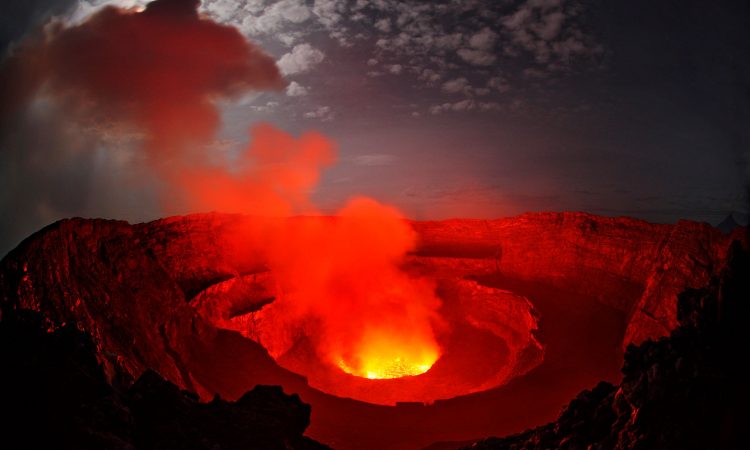
Table of contents
- Hiking Mount Nyiragongo in DR Congo; Visiting the World’s Largest Lava Lake
- What is Mount Nyiragongo?
- Where is Mount Nyiragongo?
- How Do You Get to Mount Nyiragongo and the Virunga National Park
- Why do people visit Mount Nyiragongo and Virunga National Park?
- How much does it cost to hike Mount Nyiragongo?
- How high is Mount Nyiragongo? Is altitude a problem?
- Is the Democratic Republic of Congo Safe to Visit?
- How tough is the Nyiragongo Trek?
- How about the Visa for the DR Congo?
- When’s the best time to visit Nyiragongo?
- How About Travel Insurance for the DR Congo?!
- Packing list for Hiking Mount Nyiragongo
- Hiking Mount Nyiragongo; My Personal Exprience
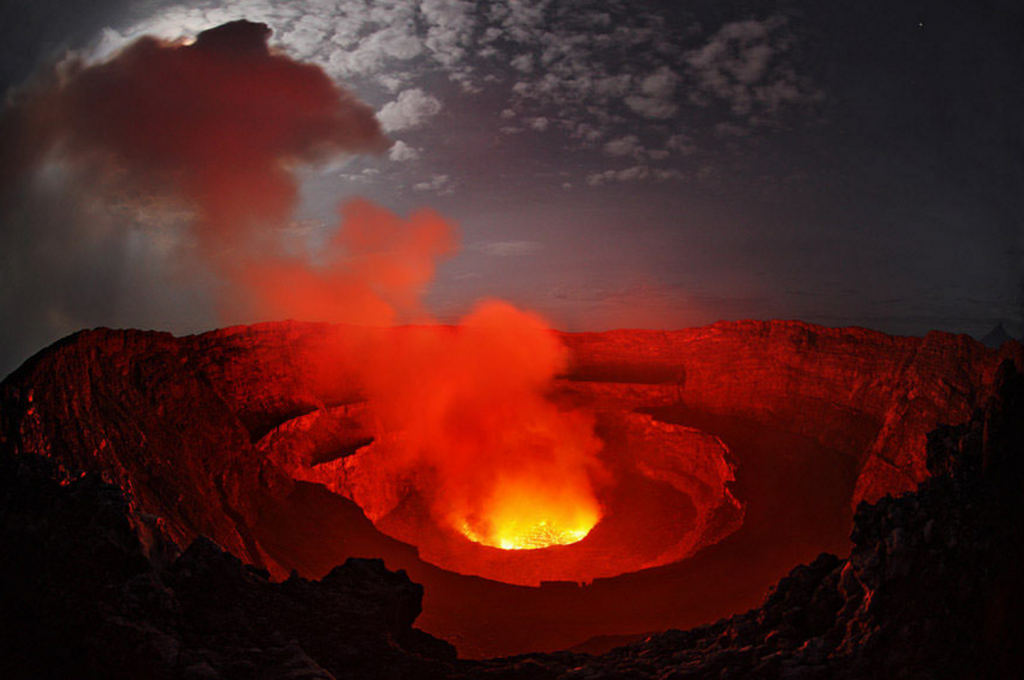
What is Mount Nyiragongo?
Mount Nyiragongo is an active volcano found in the east of the Democratic Republic of Congo, 12km north of Goma. It’s famous because it erupted in 2002, killing hundreds, and then recently erupted again in May 2021. Lava poured through the town once more, leaving 32 dead.
It’s located in the famous Virunga National Park, home to the last few groups of mountain Gorillas, made famous by a recent Netflix documentary.
It also has the world’s largest lava lake, which is where you can hike to, and camp beside, when you visit.
Where is Mount Nyiragongo?
It’s in the DRC (Democratic Republic of Congo), which is found in East Africa. The volcano itself is on the border with Rwanda and Uganda. You can see on the google map below.
How Do You Get to Mount Nyiragongo and the Virunga National Park
Visits to Nyiragongo, and the Virunga National Park, generally all originate in Goma, a city in the DR Congo. So you have to get to Goma.
To get to Goma, you can fly to Kigali in Rwanda (or fly to Goma directly from Congolese cities). Or you can take a local bus ($15) or taxi ($100) from Kigali, Rwanda. This is what most people do.
The most difficult thing about visiting Mount Nyiragongo though are the permits and the visa for the DRC.
Thankfully, now you can get both through the official website HERE.
Why do people visit Mount Nyiragongo and Virunga National Park?
There are a few reasons:
- It’s the easiest way to get access to the Democratic Republic of Congo. You get a DRC visa as par of the package.
- Virunga offers the cheapest mountain gorilla trekking, in comparison to Rwanda and Uganda.
- Or if you don’t want to trek with the mountain gorillas, you can undertake hiking Mount Nyiragongo, all the way to the summit. Here you camp in the shelters and see the lava in the world largest lava kale.
How much does it cost to hike Mount Nyiragongo?
You go via the official park to get your permits, so it would cost:
- $100 for the DRC visa
- $360 (approximately) for the hike and shelter
- $100 for the backpack + sleeping gear package
- $200 for the gorilla permit
- Fees and tips for porters and guides (they expect a minimum of $50 each).
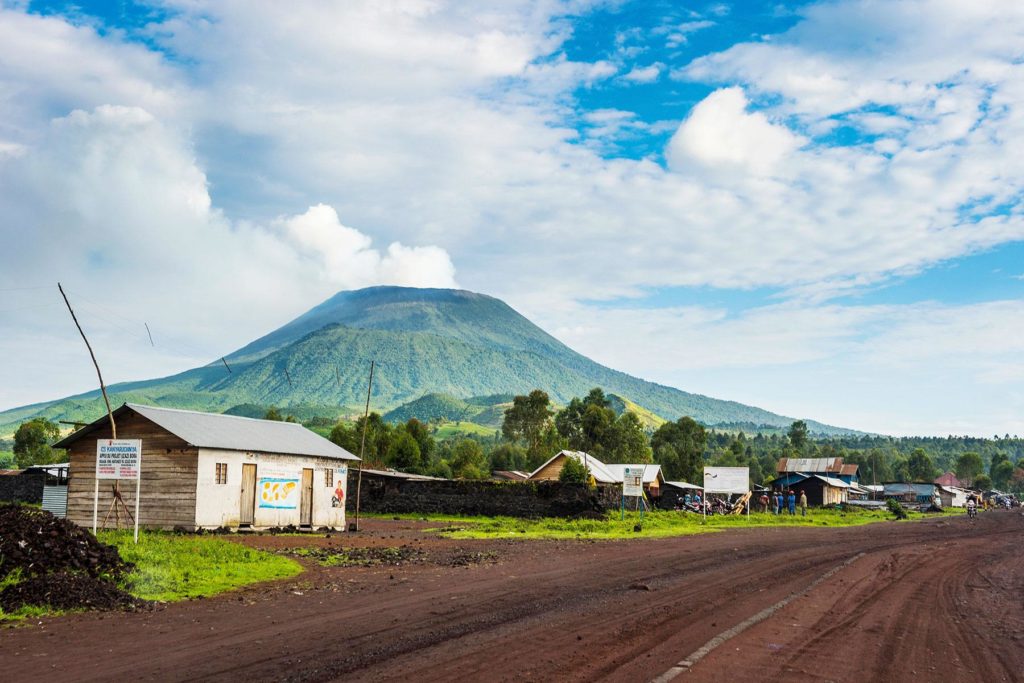
How high is Mount Nyiragongo? Is altitude a problem?
The volcano is 3,470 m (11,385 ft) high. And yes, altitude sickness can be a problem if you choose to climb it. In fact, a member of the group I was with had to be stretchered down due to altitude sickness.
Is the Democratic Republic of Congo Safe to Visit?
Hmmm. Honestly, it’s not super safe. However, if you overland from Kigali, have your hotel pre-booked in Goma, and your permits and treks organised through the official channels. Then back to your hotel in Goma, and overland back to Kigali again, you’re fine.
Solo travel through DRC though? It’s pretty hardcore.
How tough is the Nyiragongo Trek?
You start at 1800m and trek, in one day up to 3500m. That’s pretty good going! it takes 4-8 hours depending on how fit you are. And the trek is broken down into 5 stages, where at each stage all of the group will rest and then start again. I’d say it’s a 6/10. You don’t need to train for it, but if you’re seriously out of shape, I’d consider doing a bit of training for a couple of weeks beforehand.
How about the Visa for the DR Congo?
Normally a nightmare. BUT if you book to visit the gorillas, or hike Mount Nyiragongo, you can get the visa as part of the package. YAAAY!
When’s the best time to visit Nyiragongo?
It’s possible all year around, but July to September is the best time.
How About Travel Insurance for the DR Congo?!
Most travel insurance doesn’t cover you in countries like this. BUT, good news, THESE GUYS DO. $10 a week, AND they cover COVID. AND they cover you up to 4000m altitude. Perfect.

Packing list for Hiking Mount Nyiragongo
It’s a hike. Hot at the bottom, sweaty during the climb, and freezing at the top and during the night. So my ‘Hiking Mount Nyiragongo’ Packing list goes like this:
- Sunscreen
- Sunhat
- Sunglasses
- Hiking shoes (I used running sneakers, it was ok but hiking boots would be better)
- Thick socks
- Trekking pants (shorts aren’t enough, it’s freezing at the top).
- Shorts for the bottom trekking section
- 2 X T-shirts. You need 2 to layer up at night AND if one is soaking with sweat. Eurrgh.
- Hoody
- Hat and gloves
- Sleeping bag
- Inflatable pillow
- Head torch
- Power bank (no charging available)
- Snacks (meals are included)
- Thermals – top and bottom. I didn’t have them, but I wish I did!
Hiking Mount Nyiragongo; My Personal Exprience
Sometimes you have to risk a little, to get a little more back. So while both the UK and US Department of Affairs suggest all but absolutely necessary travel to the Democratic Republic of Congo is canceled immediately, I kinda thought finishing my mission to every country in the world absolutely qualifies as”Absolutely Necessary Travel”. So on I went. And figuring out how to go about hiking Mount Nyiragongo was a key part of making it possible.
Visas in Central Africa are an absolute nightmare. And the DRC is no different. While I had dreams of overlanding all the way from South Africa to Morocco up the West Coast of Africa, the visa for DRC was proving difficult unless I visited eastern DRC. Home to the Virunga national park, the mountain gorillas, and to one of the most amazing sites on the whole planet – the world’s largest lava lake. Right in the crater of the Nyiragongo volcano.

Dealing with Visas
The deal with eastern Congo is that if you buy a permit to their National Park to visit this stuff, you automatically get permission for a visa.
You can do the same thing using the official government permit website here.
The drawback? It’s $405 for the permit and visa. And that only gives you a couple of days in the park. Still, when you see either wild mountain gorillas (something I have done previously in Rwanda, AMAZING!). Or you climb the Nyiragongo Volcano and visit the lava lake. Either way I’d be happy to have parted with my money. 2 of the best things on our planet to do, honestly. Absolute travel bucket list stuff.
So I logged in, signed up, applied for my visa, had it granted, and started planning my trip. I was in Rwanda, visiting my last few countries in east Africa. So my plan was to take a shared minibus from Kigali, the Capital of Rwanda, overland to the Congolese border. Then cross into the notorious eastern city of Goma.
From there, get a hotel, then the following day, through the $405 payment, be picked up at the hotel and taken to climb the volcano. Camp overnight, see all the sights and descend the following day. Another night in Goma, then back overland to Rwanda and make my way deeper through Africa from then.
Adventure is always better with friends
Fortunately, a blogger I knew online (Kirsty from NerdyNomad.com) was randomly doing the same trek, on the same weekend as me. So I tagged along with their group which was awesome. So nice to speak English and swap travel tales with people.


Bus from Kigali to Goma
The bus ride from Kigali to DR Congo was breathtaking. Amazing vistas, huge wide expanses, and my awful little bus tootling along through these hills. The border took a little bit of work. But thankfully our visa information had been passed onto the officials on the border, a little ‘admin’ fee here and there and we were across. A short hop further onto Goma and we found our hotel.


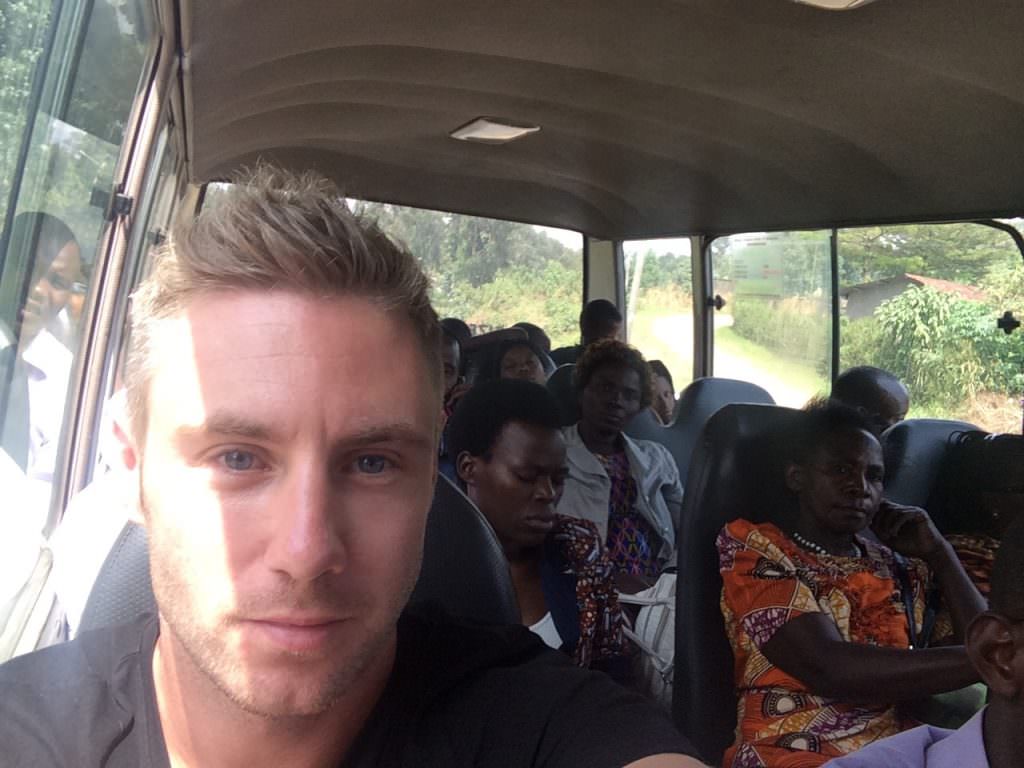
Kigali to Goma bus
Luxury in Goma
It should be pointed out that countries in Central Africa aren’t geared towards tourism. So prices are through the roof. I stayed in a dank, dingy hotel that looked pretty nice from the outside. Affordable, but not cheap, at $75 a night. And this is what I got.
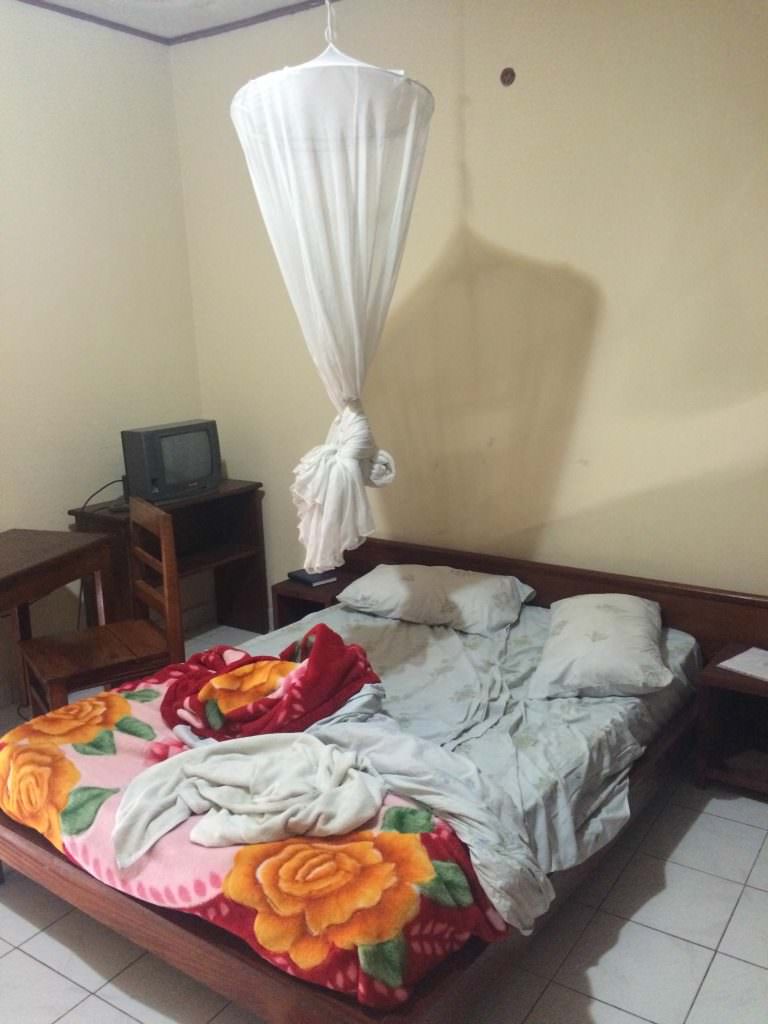
I love a bit of adventure travel. And the following night I knew I’d be camping on the side of the volcano. So when you throw yourself into crazy travels, you have to accept some dodgy conditions. All part of the fun if you ask me. So we drunk a few beers, chatted into the night, hit the sack.
Entering Virunga National Park
The next day we were picked up by the official 4x4s, driven to the Virunga National Park office, registered for our permits, and off we went.
Driving through Goma is a strange, strange experience. In 2002, the Nyiragongo volcano erupted, pouring hot molten lava right over the town, leaving 120,000 people homeless, 150 or so dead, and destroying 15% of the city entirely. The city, of course, has grown back. But there is lava rock everywhere, people have built houses out of the stuff, and still the impressive Nyiragongo volcano sits ominously in the background. Right on the doorstep of Goma, who knows when next to erupt (EDIT It recently erupted again in 2021). Scary stuff.


We drive for an hour or so to get to the foot of the volcano. Here we were greeted by our armed guards. These guys are necessary because there are rebels in the area, and gunshots are frequently heard, with some of the armed guards having lost friends in the gunfire they trade with the rebels. Not only that, the mountain gorillas are in the national park too. And poaching is a huge problem, punishable by life imprisonment. But again that doesn’t adequately deter the bad guys, so the armed guards are the defenders of the gorillas too.
Hiking Mount Nyiragongo begins
The trek soon starts, and it’s about 8 hours or so from the bottom to the top.
The summit sits around 3500m so you can definitely feel a lack of oxygen once you reach the end, making the last 1-2 hours pretty strenuous. Also, it’s hot at the bottom (being Central Africa and all), but by the time you reach the summit, and the sun begins to set, the temperature quickly plummeted to below zero. And it was very very cold!
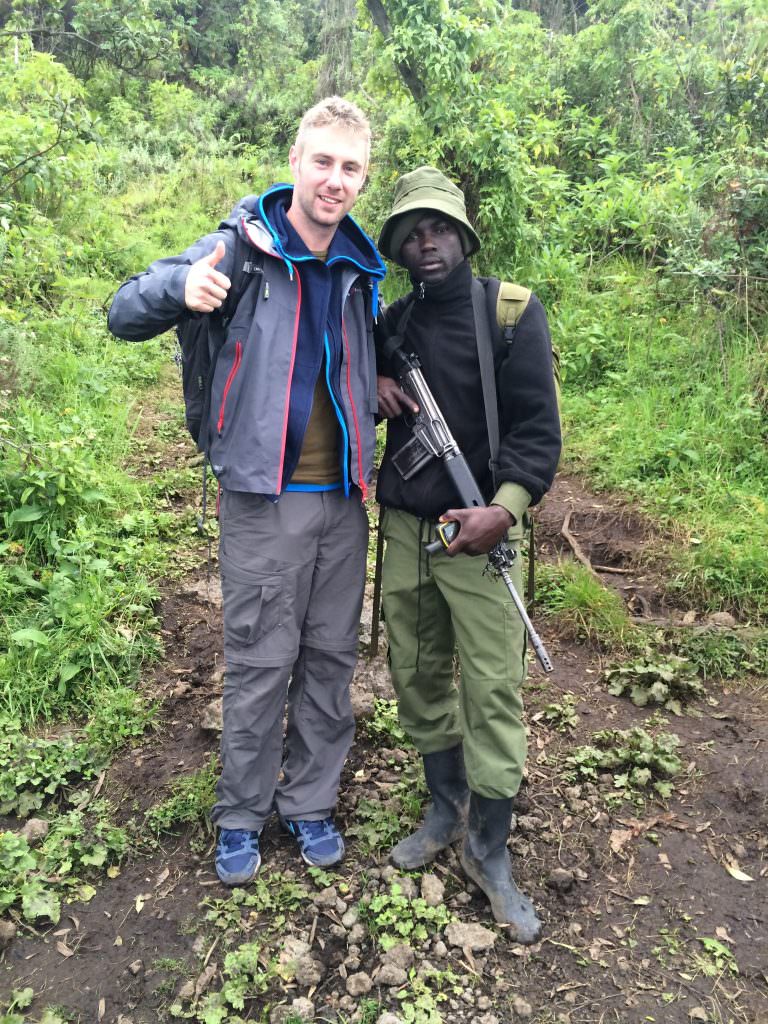
I didn’t do any training for the hike. So you don’t have to be in great shape to manage it. But don’t expect a leisurely stroll in the forest either. You’ll be tired by the time you reach the top, guaranteed.
And it’s not unheard of for people to suffer from altitude sickness and have to descend. and also for people who were a little too out of shape to fail the climb. So while you don’t have to be in fighting fit shape, remember 8 hours hiking up a steep mountain is no joke, and you have to respect it. The way up through. wow. You can see all the volcanos in the region, and the higher you get, the more impressive the views become.

Nearly at the top
The sheer beauty of central Africa somehow gives you the extra strength you need to keep going, and many times throughout the day I had to pinch myself to check if what i’m doing is real. In the depths of inner Africa, the Congo no less, climbing an active volcano, armed guards protecting us, to see the world’s largest lava lake? This is the lifestyle I’ve always dreamed of, and somehow or another, I’ve created it for myself. Proud, and grateful.


Sunset
As dusk began to settle we finally arrived at the summit, I could see the smoke billowing out of the crater. And I could smell the acidic bite of the sulphur in the air. And although the hike had tired me out, all I wanted to do was get to the lip of the crater and see the lava!
So I summoned my last bit of energy and sprinted to the end. Wow – there it was. Real lava, bubbling away. It wasn’t yet dark so it wasn’t as striking as the pics on the net, that would come around midnight. But it was still mightily impressive. A Chinese national had recently fallen into the crater 2 months before. So I was trying to be extra careful, not a nice way to go.
The porters (compulsory as part of the visa package) set up the tents. We put on whatever warm clothes we had dinner together while we waited for the pitch black to set in. When it did, the lava subsided a little so we went to sleep and the guards told us they’d wake us if it really took off. Which around 1am it did. What a sight.
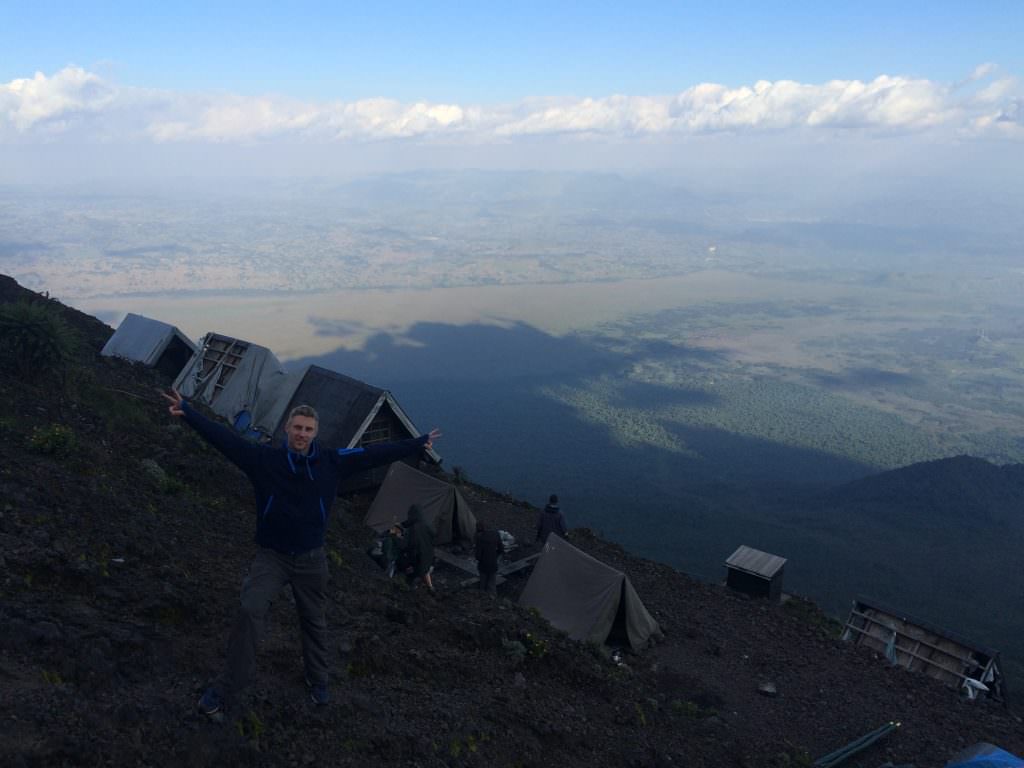

Lava at night
We all sat around the lip of the crater for about an hour, not saying anything. Just soaking up the sounds, smells and sights of this amazing place. One of the most spectacular things I’ve certainly ever seen, and worth all the hassle, bureaucracy and costs involved getting in.
I went to bed to escape the cold with a huge smile of my face. One of the other members of our group though was struggling with altitude sickness badly and had to be carried down on a stretcher in the pitch black. A stark reminder of the dangers involved with truly intrepid travel, Thankfully, she was ok after descending.

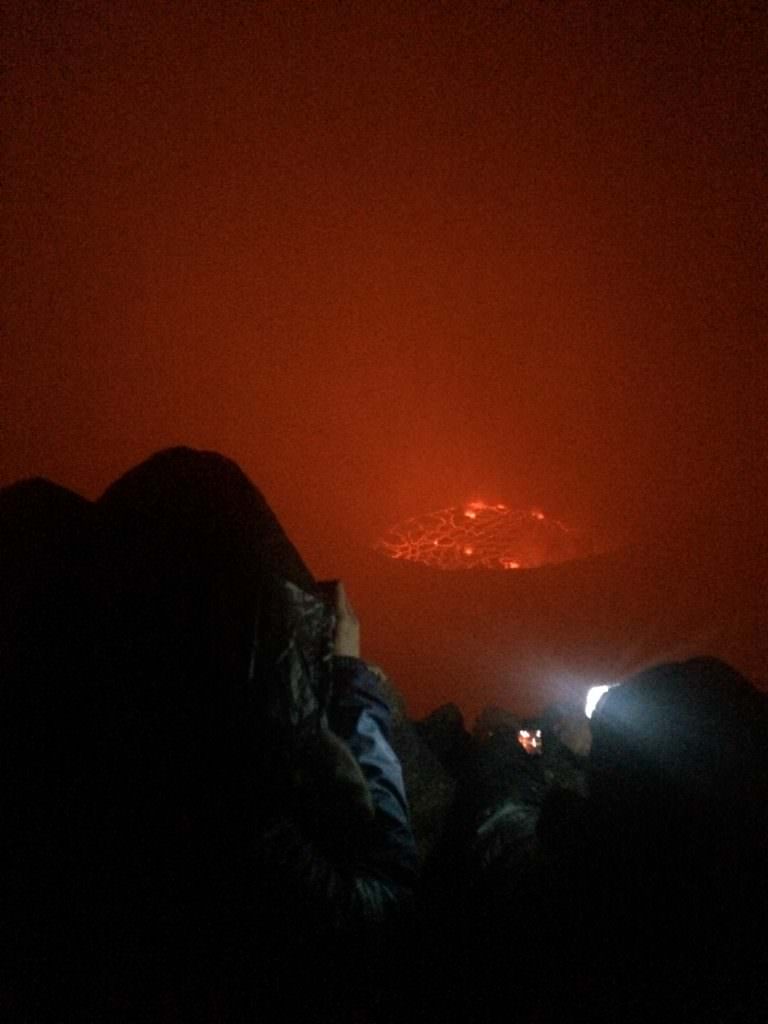
The descent
We woke up super early the next day, quick breakfast in the freezing cold, and we began the descent. 4 hours later we’re at the bottom, all truly knackered but very fulfilled with an amazing couple of days, the bullet holes in the park’s sign compounding the feeling of how fortunate we are to be able to witness such a place.
So back to Goma we went, before long I was on another shared minibus back to Kigali, Rwanda. Another country off my list, a super tough one at that, and what a way to do it. Just go here, and thank me when you come back! Happy travels!
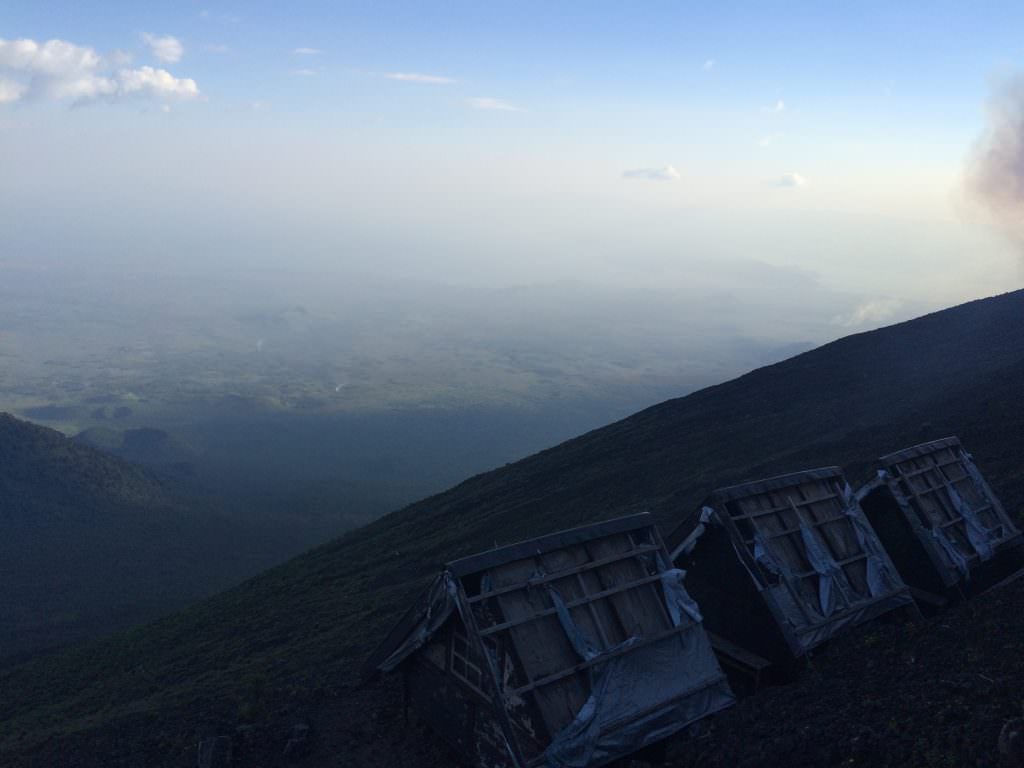

Remember, never travel without travel insurance! And never overpay for travel insurance!
I use HeyMondo. You get INSTANT quotes. Super cheap, they actually pay out, AND they cover almost everywhere, where most insurance companies don't (even places like Central African Republic etc!). You can sign-up here. PS You even get 5% off if you use MY LINK! You can even sign up if you're already overseas and traveling, pretty cool.
Also, if you want to start a blog...I CAN HELP YOU!
Also, if you want to start a blog, and start to change your life, I'd love to help you! Email me on johnny@onestep4ward.com. In the meantime, check out my super easy blog post on how to start a travel blog in under 30 minutes, here! And if you just want to get cracking, use BlueHost at a discount, through me.
Also, (if you're like me, and awful with tech-stuff) email me and my team can get a blog up and running for you, designed and everything, for $699 - email johnny@onestep4ward.com to get started.
Do you work remotely? Are you a digital nomad/blogger etc? You need to be insured too.
I use SafetyWing for my digital nomad insurance. It covers me while I live overseas. It's just $10 a week, and it's amazing! No upfront fees, you just pay week by week, and you can sign up just for a week if you want, then switch it off and on whenever. You can read my review here, and you can sign-up here!







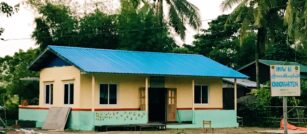
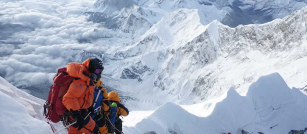
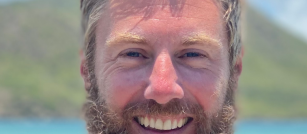
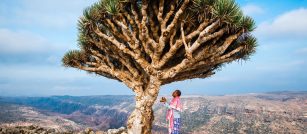
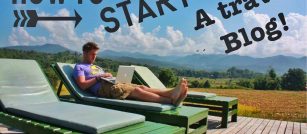
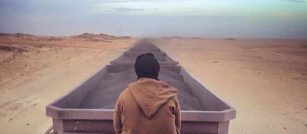
 As you know, blogging changed my life. I left Ireland broke, with no plan, with just a one-way ticket to Thailand
and no money. Since then, I started a blog, then a digital media company, I've made
more than $1,500,000 USD, bought 4 properties and visited (almost) every country in the world. And I did it all from my laptop as I
travel the world and live my dream. I talk about how I did it, and how you can do it too, in my COMPLETELY FREE
Ebook, all 20,000
words or so. Just finish the process by putting in your email below and I'll mail it right out to you immediately. No spam ever too, I promise!
As you know, blogging changed my life. I left Ireland broke, with no plan, with just a one-way ticket to Thailand
and no money. Since then, I started a blog, then a digital media company, I've made
more than $1,500,000 USD, bought 4 properties and visited (almost) every country in the world. And I did it all from my laptop as I
travel the world and live my dream. I talk about how I did it, and how you can do it too, in my COMPLETELY FREE
Ebook, all 20,000
words or so. Just finish the process by putting in your email below and I'll mail it right out to you immediately. No spam ever too, I promise!
